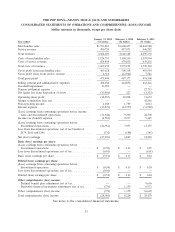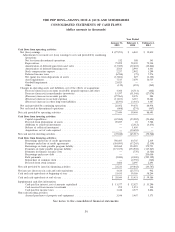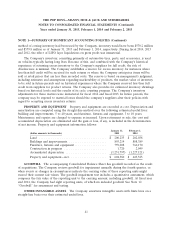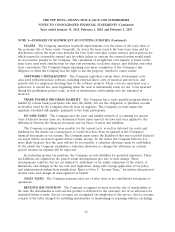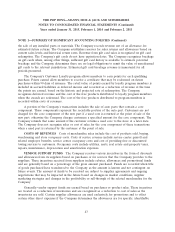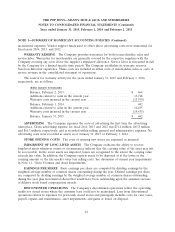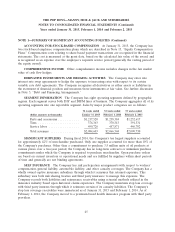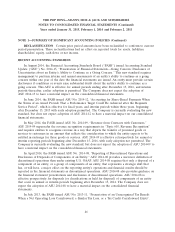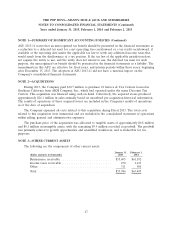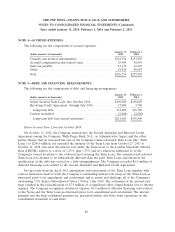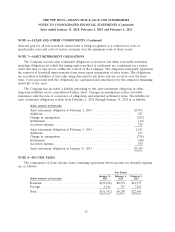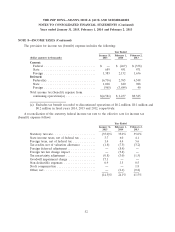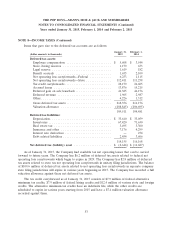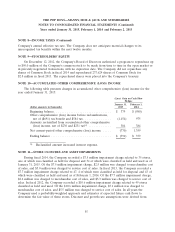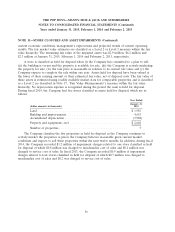Pep Boys 2014 Annual Report Download - page 52
Download and view the complete annual report
Please find page 52 of the 2014 Pep Boys annual report below. You can navigate through the pages in the report by either clicking on the pages listed below, or by using the keyword search tool below to find specific information within the annual report.THE PEP BOYS—MANNY, MOE & JACK AND SUBSIDIARIES
NOTES TO CONSOLIDATED FINANCIAL STATEMENTS (Continued)
Years ended January 31, 2015, February 1, 2014 and February 2, 2013
NOTE 1—SUMMARY OF SIGNIFICANT ACCOUNTING POLICIES (Continued)
RECLASSIFICATION Certain prior period amounts have been reclassified to conform to current
period presentation. These reclassifications had no effect on reported totals for assets, liabilities,
shareholders’ equity, cash flows or net income.
RECENT ACCOUNTING STANDARDS
In August 2014, the Financial Accounting Standards Board (‘‘FASB ’’) issued Accounting Standard
Update (‘‘ASU’’) No. 2014-15, ‘‘Presentation of Financial Statements—Going Concern: Disclosure of
Uncertainties about an Entity’s Ability to Continue as a Going Concern.’’ This new standard requires
management to perform interim and annual assessments of an entity’s ability to continue as a going
concern within one year of the date the financial statements are issued. An entity must provide certain
disclosures if conditions or events raise substantial doubt about the entity’s ability to continue as a
going concern. This ASU is effective for annual periods ending after December 15, 2016, and interim
periods thereafter; earlier adoption is permitted. The Company does not expect the adoption of
ASU 2014-15 to have a material impact on the consolidated financial statements.
In June 2014, the FASB issued ASU No. 2014-12, ‘‘Accounting for Share-Based Payments When
the Terms of an Award Provide That a Performance Target Could Be Achieved after the Requisite
Service Period’’, which is effective for fiscal years, and interim periods within those years, beginning
after December 15, 2015 with early adoption permitted. The Company is currently evaluating the new
standard, but does not expect adoption of ASU 2014-12 to have a material impact on our consolidated
financial statements.
In May 2014, the FASB issued ASU No. 2014-09, ‘‘Revenue from Contracts with Customers.’’
ASU 2014-09 supersedes the revenue recognition requirements in ‘‘Topic 605, Revenue Recognition’’
and requires entities to recognize revenue in a way that depicts the transfer of promised goods or
services to customers in an amount that reflects the consideration to which the entity expects to be
entitled in exchange for those goods or services. ASU 2014-09 is effective retrospectively for annual or
interim reporting periods beginning after December 15, 2016, with early adoption not permitted. The
Company is currently evaluating the new standard, but does not expect the adoption of ASU 2014-09 to
have a material impact on the consolidated financial statements.
In April 2014, the FASB issued ASU No. 2014-08, ‘‘Reporting of Discontinued Operations and
Disclosures of Disposals of Components of an Entity.’’ ASU 2014-08 provides a narrower definition of
discontinued operations than under existing U.S. GAAP. ASU 2014-08 requires that only a disposal of a
component of an entity, or a group of components of an entity, that represents a strategic shift that
has, or will have, a major effect on the reporting entity’s operations and financial results should be
reported in the financial statements as discontinued operations. ASU 2014-08 also provides guidance on
the financial statement presentations and disclosures of discontinued operations. ASU 2014-08 is
effective prospectively for disposals (or classifications as held for disposal) of components of an entity
that occur in annual or interim periods beginning after December 15, 2014. The Company does not
expect the adoption of ASU 2014-08 to have a material impact on the consolidated financial
statements.
In July 2013, the FASB issued ASU No. 2013-11, ‘‘Presentation of an Unrecognized Tax Benefit
When a Net Operating Loss Carryforward, a Similar Tax Loss, or a Tax Credit Carryforward Exists’’.
46



